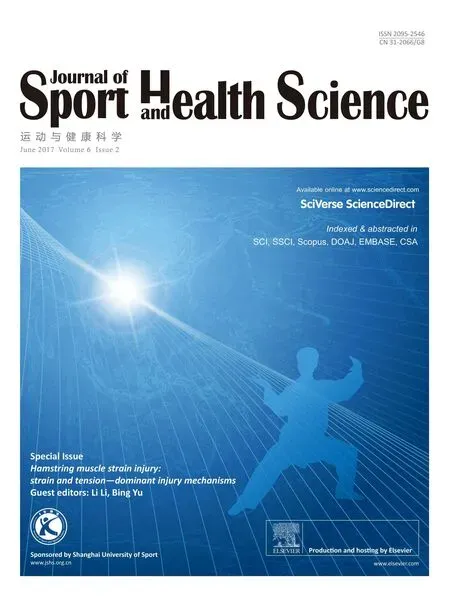Eccentric vs.concentric muscle contraction:That is the question
2017-11-27WalterHerzog
Eccentric vs.concentric muscle contraction:That is the question
In their recent papers in theJournal of Sport and Health Scienceon hamstring injuries in sprinting,1,2and their corresponding commentaries on each other’s research,3,4Yu et al.and Liu et al.proposed different views of the mechanisms of muscle injuries in general,and hamstring injuries in sprinting speci fically.While Yu et al.1,3argued that muscle injuries are primarily, if not exclusively,caused by muscle strain magnitude in eccentric contractions,and thus hamstring injuries occur primarily at the end of the swing phase in sprinting when the hamstrings are in eccentric mode and at their longest lengths,Liu et al.,2,4proposed that muscle injuries may also occur when muscle forces are extremely high in concentric contractions,as occurs in the early phase of stance in sprinting.
Although I might not be able to solve the problem of when hamstring injuries occur in sprint running,I felt that the idea of eccentric contraction deserved more attention than it received, particularly because it seemed crucial to the hamstring injury discussion.However,neitherYu et al.,1,3nor Liu et al.2,4de fined eccentric contraction,nor did they explain on what structural level they thought eccentric contractions should be considered in the context of muscle injury.
Let’s take another look at what scientists may mean when discussing eccentric hamstring injury mechanisms.Eccentric contractions are typically thought of as a lengthening(stretching or elongation)of the entire,active hamstring muscle tendon unit. However,one could make an equally valid argument that it is not the stretching of the muscle tendon unit that is important in hamstring injuries,but the elongation of the contractile machinery,the fibers and fascicles.If we adopt this latter view,the whole issue of eccentric contraction becomes more complex,as muscle fiber length changes are known to notonly depend on muscle length but also on muscle force changes.Simply stated,when a muscle is stretched, fibers tend to be stretched too(although usually to a much smaller degree than the muscle tendon unit,e.g.,Vaz et al.5), and when muscle force increases,fascicle lengths tend to decrease (e.g.,de Brito Fontana and Herzog6).
Toward the end of the swing phase in sprinting,the hamstring muscle tendon unit lengths and the hamstring forces increase.But,what about the muscle fibers?Do they increase (because of the muscle stretching)or decrease(because of the force increase)?I do not think anybody knows for sure,butthere is a good possibility that the muscle fibers are shortening (concentric contraction)in this crucial phase of sprint running. Such behavior,where the muscle tendon unit is stretched and the fibers are shortening,has been observed many times and for many movements ever since the classic sonomicrometry experiments on the medial gastrocnemius of cats during free locomotion.7If this were indeed the case for the hamstring mechanics in the late swing phase of sprinting,would the injury then be due to the eccentric(muscle)or due to the concentric ( fiber)contraction?
And maybe we have it all wrong anyway.Maybe hamstring injuries have nothing to do with eccentric loading and the mechanics of the muscles in sprint running.Maybe hamstring injuries occur because of a“loss”of motor control,a“lack”of focus when sprinting.I have watched track and field sprinting for 50 years now.And in all that time,I cannot recall having seen a leading sprinter pull up with a hamstring injury,but sprinters in losing positions do it all the time.Why is that?One of the most famous examples is the 1997 Toronto Skydome 150 m sprint between Donovan Bailey and Michael Johnson,the 100 m and 200 m world record holders at the time.Donovan Bailey clearly leads coming out of the turn,and Michael Johnson pulls up with a hamstring injury in a losing position.Would he also have injured his hamstring had he been leading the race?Ido notthink so.Did he“lose”focus on his sprint technique,did he change his muscle activation patterns in a futile attempt to catch Bailey,did he“strain”more than he normally would have if he had been leading the race?We will never know,but maybe hamstring injuries are not mechanically mediated,not caused by eccentric contraction,but caused by a small change in hamstring activation when attempting to come from behind in a sprint race,or when tightening up in a losing position.
1.Yu B,Liu H,Garrett WE.Mechanism of hamstring muscle strain injury in sprinting.J Sport Health Sci2017;6:130–2.
2.Liu Y,Sun Y,Zhu W,Yu J.The late swing and early stance of sprinting are most hazardous for hamstring injuries.J Sport Health Sci2017;6:133–6.
3.Yu B,Liu H,Garrett WE.Comment on“The late swing and early stance of sprinting are most hazardous for hamstring injuries”by Liu et al.J Sport Health Sci2017;6:137–8.
4.Liu Y,Sun Y,Zhu W,Yu J.Comments to“Mechanism of hamstring muscle strain injury in sprinting”by Yu et al.J Sport Health Sci2017;6:139–40.
5.Vaz MA,de la Rocha Freitas C,Leonard T,Herzog W.The force-length relationship of the cat soleus muscle.Muscles Ligaments Tendons J2012;2:79–84.
6.de Brito Fontana H,Herzog W.Vastus lateralis maximum force-generating potential occurs at optimal fascicle length regardless of activation level.Eur J Appl Physiol2016;116:1267–77.
7.Grif fiths RI.Shortening of muscle fibres during stretch of the active cat medial gastrocnemius muscle:the role of tendon compliance.J Physiol1991;436:219–36.
Walter Herzog,co-Editor-in-Chief
Human Performance Laboratory,Faculty of Kinesiology,
University of Calgary,Calgary
AB T2N 1N4,Canada
E-mail address:wherzog@ucalgary.ca
Accepted 19 December 2016
Available online 12 January 2017
Peer review under responsibility of Shanghai University of Sport.
http://dx.doi.org/10.1016/j.jshs.2017.01.006
2095-2546/©2017 Production and hosting by Elsevier B.V.on behalf of Shanghai University of Sport.This is an open access article under the CC BY-NC-ND license(http://creativecommons.org/licenses/by-nc-nd/4.0/).
杂志排行
Journal of Sport and Health Science的其它文章
- Erratum to“Effects of music and video on perceived exertion during high-intensity exercise”[J Sport Health Sci 6(2017)81–88]
- Erratum to“A systematic review of active video games on rehabilitative outcomes among older patients”[J Sport Health Sci 6(2017)33–43]
- Erratum to“Children’s expectancy beliefs and subjective task values through two years of school-based program and associated links to physical education enjoyment and physical activity”[J Sport Health Sci 5(2016)500–508]
- Promoting physical activity among Chinese youth:No time to wait
- Could titin have a role in strain-induced injuries?
- Parallel and cross-sectional hamstring injuries in sprint running
